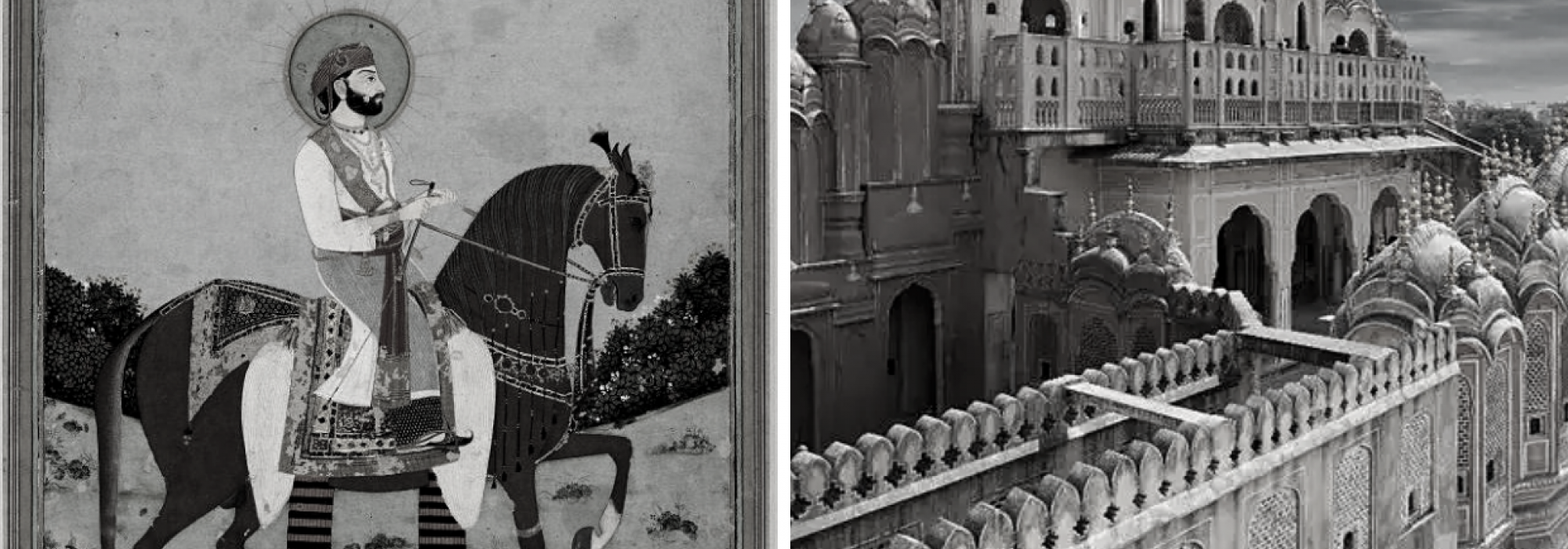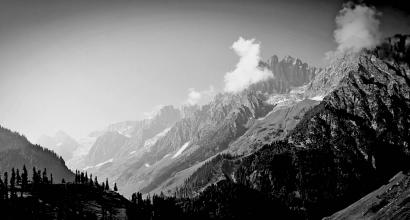In this background, there were several heroes who strove to alleviate the pain of the Sanatana-Dharmis and protect their honour. Such people are worthy of the highest praise.
Of them, the foremost was Sawai Jai Singh.
From the time of Akbar, the Rajputs from the province of Amber (or Amer) were loyal to the Mughal empire with Delhi as its capital; Sawai Jai Singh belonged to this clan of Rajputs. Although he grew up having to bear all the anti-Hindu insults in the Mughal court at Delhi just like his ancestors, he enjoyed more freedom since he was born during the period of Aurangzeb's decline. Also, because he was a source of support to Bahadur Shah Zafar, the weakling successor of Aurangzeb, on many occasions, he was given honorific titles like Sawai and Rajadhiraja. In spite of this, Jai Singh ensured the unity of the Rajputs and worked towards the cause.
Like Rana Pratap, he too had the valour and fortitude to take the Mughals head on and emerge successful. However, he also had the intelligence and acumen to remain within the system and nurture his rebellion. This is an aspect of patient survival that comes from kshaatra-sattva, the spirit of valour tempered by wisdom. Forceful attacks cannot always be used. Further, it is also a factor of the particular warrior's temperament. As he built the Rajput group while staying within the Mughal establishment, friends and allies who supported him include Amar Singh of Mewar, Ajit Singh of Marwar, and his trusted commander-minister-guide Durgadas. A few others gave their support but ended up being fair weather friends. Even outsiders like Chhatrasal of Bundelkhand supported Jai Singh.
Although Sawai Jai Singh was constantly occupied in battles and negotiations with allies and enemies, he was firm in his understanding of the holism of Sanatana Dharma on the one hand and the barbarism of Islam on the other.
From the beginning he was intimately familiar with Muslim kings, the practices and rules of the faith, and the pettiness-injustice-intolerance of Islam. Therefore he realized early on that the counter to this could only come from a united group of Rajputs, Marathas, Sikhs, and Jats, and he worked tirelessly to make it a reality. He cleverly used his position in the Mughal court and tried to broker a special alliance between the Rajputs and the Marathas. Due to all these efforts he attained the favour of both Peshwa Baji Rao on one hand and the Mughal ruler on the other.
Using the sort of influence he wielded, he removed the jizya tax that was levied on tirthayatras and at tirthakshetras forever. He gets all the credit for this noble act. When Bahadur Shah offered him a reward of two crores, he declined it and instead asked for an order for a permanent removal of the tax!
Further, he had rest houses and Dharmashalas built at Mathura, Brindavan, Kashi, Gaya, Pune, Kabul, Lahore, Agra, Delhi, Chitrakoot, Ayodhya, Haridwar, Ujjain, and other sacred spots, thus becoming a source of support to weary travelers. In all such cases, he freely used the power that he gained by being close to the central authority. Later, in due course, he became the unchallenged chief of the Rajputs and completely ignored the Mughal empire. He began focusing on activities of consolidating and uniting the Hindus. Jai Singh realized that it was the Marathas who would next become the great force that would rule Bharata. He derived peace and solace from this.
Jai Singh was both an able administrator and a fierce warrior. During his rule, he had all the official records written in Sanskrit, Farsi, and the local languages of the provinces. He gets the credit for bringing back Sanskrit as a language for official communication. His force of 50,000 soldiers who were all well-educated was the most modern army in the whole of India. He had extensive knowledge about weapons, guns, gunpowder, bullets, canons, and so on. He imported several books on various subjects from different parts of the world. He also invited several scholars and scientists from all over and had them compose new treatises. He himself was a great scholar. He had studied the Vedas, Vedangas, Vedanta, and other subjects. He brought a stop to extravagantly lavish weddings, female infanticide, etc. through strict orders.
He is the architect of modern Jaipur. He built this city adhering to the traditional Indian architectural design for a town but with the use of the latest technology available during his time. Not only that, he also nourished commerce, arts, farming, trade, employment, and so on. Hariharaadvaita, the spirit of bhakti, and adherence to traditional practices and rituals developed greatly during his period.
Jai Singh was deeply passionate about astronomy. He was thoroughly learned in revision of the calendars (panchanga), the movement of the stars and planets, observing the night sky, and so forth. He encouraged the study of these subjects. He designed and built huge observatories in Delhi, Mathura, Jaipur, Varanasi, and Ujjain. He took the knowledge of astronomy as understood by the Europeans and the Arabs and comparatively studied it with the traditional Indian science of jyautisha.
This is a great achievement of his. He invited great astronomers from Europe, Iran, and Arabia to his Vedhashaala in Jaipur and sent Indian scholars abroad, to the centers of learning in those places. Perhaps, this was the first time that the knowledge of the Vedas went abroad. He was responsible for the Sanskrit translation of works like Euclid's treatise on Geometry and Ptolemy's work on Chemistry.
Sawai Jai Singh conducted four great kshatriya yagas including the famed Ashvamedha during the years 1734–35. The Ashvamedha yajna, an indicator of the spirit of kshaatra and development of the kingdom, a veritable milestone in the history of a land, was undertaken only by a few greats – Bharata, Dilipa, Sri Rama, and Yudhishtira, followed by Pushyamitra Shunga, Gautamiputra Shatakarni, Samudragupta, Pulakeshi, and Raja Raja Chola among the most distinguished rulers. It is only Jai Singh who conducted the Ashvamedha yajna in the medieval period, in the midst of all the chaos created by Islam, almost as a meaningful response: in all its Vedic and worldly glory, thus attaining limitless fame. Earlier, in 1708, he had conducted the Vajapeya yaga.
In this manner Sawai Jai Singh, with his mastery over both shastra (weapons, warfare) and shaastra (various sciences), upheld Sanatana Dharma using the precepts of the Shukra-niti and Brihaspati-niti to the best of his abilities, thus earning a lofty place in our country's history forever.
To be continued





































